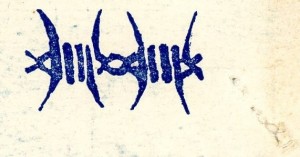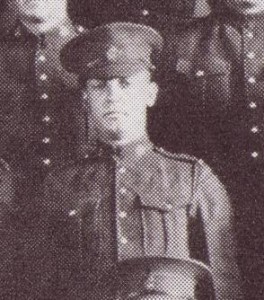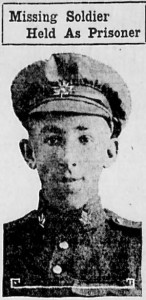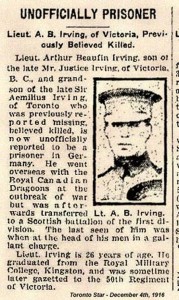Behind the Wire 1916
16th Battalion C.E.F. Prisoners of War (Part 2)

Barbed wire, familiar to all soldiers on the Western Front and elsewhere. The barbed wire symbol, in this instance of French origin, was sometimes used by Prisoners of War veteran’s organizations.
...the enemy opened a heavy bombing attack against the left flank. Sergeant Slessor was wounded and captured – he died three days afterwards. His post was overwhelmed. Only after hard fighting was this onslaught stopped and the block retaken. (Urquhart, The Sixteenth, page 183)
See also Behind the Wire 1915 and Behind the Wire 1918.
(DATES OF CAPTURE IN BOLD)
19 July 1916
Warren, John Henry
Private 130200
Released 12 December 1919
8 October 1916
Balfour, Robert
Private 420377
Died of Wounds as Prisoner of War 12 October 1916
Gunshot wound – head
Held as Prisoner of War at Marcoing, Nord, France
Son of Mr. & Mrs. R. Balfour, Easterbank, Forfar, Scotland
Buried St. Souplet British Cemetery, Nord, France. Age 23
Boyle, Thomas Edward
Private 700073
Died of Wounds as Prisoner of War 21 December 1916
Gunshot wound – back. Also reported as wounded in hip when caught in barbed wire entanglement
Held at Festungs, Koln, Germany
Only son of Thomas H. and Beatrice Boyle, 309 Redwood Avenue, Winnipeg, Manitoba
Buried Brussels Town Cemetery, Evere, Belgium. Age 21
Bradshaw, Blake
Private 420483
Released 15 June 1918
Shand, Alexander Tocher
Private 421047
Died of Wounds as Prisoner of War 25 October 1916
Son of James and Barbara Tocher Shand, of Mill of Forgue, Huntley, Aberdeenshire, Scotland
Buried Hamburg Cemetery, Germany
Died of Wounds (Gunshot wounds left thigh and left breast) whilst Prisoner of War at PARCHIM, GERMANY
(Canada, War Graves Registers (Circumstances of Casualty), 1914-1948)
Slessor, George H.
Lance Sergeant 29402
Died of Wounds as Prisoner of War 10 October 1916
No. 11 Platoon
Husband of Mary Slessor, 128 Wellington Road, Aberdeen, Scotland
Buried Porte de Paris Cemetery, Cambrai, France. Age 44
Numbers 11 and 12 platoons early met with misadventure [27 September 1916]. Their guide bore to far to the right. With little warning, they found themselves advancing against a heavily manned German trench, from which fire was opened on them with rifles and machine guns. Fortunately the warning they had received enabled them to retire with few casualties, but with the loss of Sergeant Slessor of Number 11 platoon. Slessor lost his bearings, He wandered into an unoccupied part of the Kenora Trench, where he was found next morning, all by himself, sound asleep with his head pillowed on a dead German. (Ibid, page 179)
Smith, John Albert
Private 700080
Died of Wounds as Prisoner of War 1 November 1916
Brother of Mrs. William Smart, 7 Edgewood Crescent, Toronto, Ontario
Buried Porte de Paris Cemetery, Cambrai, France

John Albert Smith, from 9th Platoon, C Company, 101st Battalion CEF booklet via the Canadian Virtual War Memorial.
Thomson, Peter Samuel
Private 427353
Released 12 January 1918
Leg amputated
Woodfine, James Moore
Private 105876
Released 26 September 1916
Amputation
8/9 October 1916
Armstrong, Henry Owen
Private 700996
Released 30 November 1918
Bent, George
Private 700398
Released 6 January 1919
Boden, George Henry
Private 129076
Released 15 December 1918
Burt, Frederick Audry
Private 199110
Released 2 December 1918
Cook, James Ray
Private 871467
Released 18 December 1918
Emerson, George Gordon
Private 426941
Released 29 November 1918
Fellows, Alfred
Private 701176
Released 12 December 1916
Foote, George Windsor
Private 488802
Released 4 December 1918
Galloway, Robert Neil
Lance Corporal 29445
Released 24 December 1918
Green, Arthur Charles
Private 105339
Released 12 January 1919
Oliver, Alfred
Private 77647
Released 15 December 1918
Ousey, John Percival
Private 700222
Released 12 January 1919
Scherbauk, Peter
Private 417655
Released 12 January 1919
Smith, Reginald Arthur
Private 105554
Released 2 January 1919
Steeds, Leslie Arthur
Private 700170
Released 2 January 1919
Thorp, Gilbert
Private 152705
Released 27 December 1918
Ussher, Noel
Private 420575
Released 8 December 1918
Walker, William Henry
Private 426322
Released 12 January 1919
9 October 1916
Irving, Arthur Beaufin
Lieutenant
Died of Wounds as Prisoner of War 9 October 1916
Son of Paulus H. Milius Irving and Diana Irving, 622 Cook Street, Victoria, British Columbia
Graduate of Royal Military College, Kingston, Ontario
Formerly of the Royal Canadian Dragoons
Commemorated on the Canadian National Vimy Memorial, Vimy, France. Age 26
List of Prisoners of War (16th Battalion CEF) compiled from:
Wigney, Edward H. “Guests of the Kaiser; Prisoners-of-War of the Canadian Expeditionary force 1915-1918”, (CEF Books, 2008)



Behind the Wire 1915 (Part One) of this subject was published January 18, 2016 . An image of Private Richard Siberry’s marker was added at the same time.
Details of Alexander Tocher Shand added.
Behind the Wire (Part Three) of this subject was published January 10, 2020. Link added.